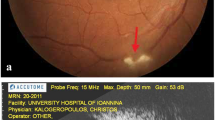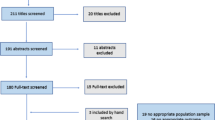Abstract
Purpose
To report a case of toxic optic neuropathy caused by an ocular bee sting.
Methods
Case report and literature review.
Results
A 44-year-old female presented with no light perception vision 2 days after a corneal bee sting in her right eye. She was found to have diffuse cornea edema with overlying epithelial defect and a pinpoint penetrating laceration at 6 o’clock. There was an intense green color to the cornea. The pupil was fixed and dilated with an afferent pupillary defect. A small hyphema was seen, and a dense white cataract had formed. A diagnosis of toxic endophthalmitis with associated toxic optic neuropathy was made. The patient underwent pars plana vitrectomy and lensectomy with anterior chamber washout. She was also placed on systemic broad-spectrum antibiotics. She had noted clinical improvement over the course of her hospitalization and was discharged with light perception vision. A corneal opacity precluded viewing of the fundus. We utilized ganzfeld electroretinography and flash visual evoked potentials (2 and 10 Hz) to assess the visual function. Both tests were normal and predicted improvement following restorative surgery. She underwent a secondary lens implantation with penetrating keratoplasty 7 months later. This was followed by an epiretinal membrane peel 1 year after the bee sting. Her best corrected visual acuity improved to 20/80.
Conclusion
Toxic endophthalmitis and toxic optic neuropathy can be complications of ocular bee sting. We discuss the management of this rare occurrence and the role of electroretinographic testing and visual evoked potentials in predicting visual outcome.




Similar content being viewed by others
References
Steen CJ, Janniger CK, Schutzer SE, Schwartz RA (2005) Insect sting reactions to bees, wasps, and ants. Int J Dermatol 44(2):91–94. https://doi.org/10.1111/j.1365-4632.2005.02391.x
Gurlu VP, Erda N (2006) Corneal bee sting-induced endothelial changes. Cornea 25(8):981–983. https://doi.org/10.1097/01.ico.0000226364.57172.72
Roomizadeh P, Razmjoo H, Abtahi MA, Abtahi SH (2013) Management of corneal bee sting: is surgical removal of a retained stinger always indicated? Int Ophthalmol 33(1):1–2. https://doi.org/10.1007/s10792-012-9655-9
Teoh SC, Lee JJ, Fam HB (2005) Corneal honeybee sting. Can J Ophthalmol 40(4):469–471. https://doi.org/10.1016/S0008-4182(05)80008-0
Arcieri ES, Franca ET, de Oliveria HB, De Abreu Ferreira L, Ferreira MA, Rocha FJ (2002) Ocular lesions arising after stings by hymenopteran insects. Cornea 21(3):328–330
Gilboa M, Gdal-On M, Zonis S (1977) Bee and wasp stings of the eye. Retained intralenticular wasp sting: a case report. Br J Ophthalmol 61(10):662–664
King TP, Spangfort MD (2000) Structure and biology of stinging insect venom allergens. Int Arch Allergy Immunol 123(2):99–106. https://doi.org/10.1159/000024440
Chen CJ, Richardson CD (1986) Bee sting-induced ocular changes. Ann Ophthalmol 18(10):285–286
Smolin G, Wong I (1982) Bee sting of the cornea: case report. Ann Ophthalmol 14(4):342–343
Odom JV, Bach M, Brigell M, Holder GE, McCulloch DL, Mizota A, Tormene AP, International Society for Clinical Electrophysiology of Vision Annual Course (2016) ISCEV standard for clinical visual evoked potentials: (2016 update). Doc Ophthalmol 133(1):1–9. https://doi.org/10.1007/s10633-016-9553-y
Marmor MF, Holder GE, Seeliger MW, Yamamoto S, International Society for Clinical Electrophysiology of Vision Annual Course (2004) Standard for clinical electroretinography (2004 update). Doc Ophthalmol 108(2):107–114
Cavender SA, Hobson RR, Chao GM, Weinstein GW, Odom JV (1992) Comparison of preoperative 10-Hz visual evoked potentials to contrast sensitivity and visual acuity after cataract extraction. Doc Ophthalmol 81(2):181–188
Odom JV, Hobson R, Coldren JT, Chao GM, Weinstein GW (1987) 10-Hz flash visual evoked potentials predict post-cataract extraction visual acuity. Doc Ophthalmol 66(4):291–299
Kim JM, Kang SJ, Kim MK, Wee WR, Lee JH (2011) Corneal wasp sting accompanied by optic neuropathy and retinopathy. Jpn J Ophthalmol 55(2):165–167. https://doi.org/10.1007/s10384-010-0912-z
Maltzman JS, Lee AG, Miller NR (2000) Optic neuropathy occurring after bee and wasp sting. Ophthalmology 107(1):193–195
Choi MY, Cho SH (2000) Optic neuritis after bee sting. Korean J Ophthalmol 14(1):49–52. https://doi.org/10.3341/kjo.2000.14.1.49
Song HS, Wray SH (1991) Bee sting optic neuritis. A case report with visual evoked potentials. J Clin Neuroophthalmol 11(1):45–49
Acknowledgements
We thank Anthony Viti, MD, for his assistance.
Funding
No funding was received for this research.
Author information
Authors and Affiliations
Corresponding author
Ethics declarations
Conflict of interest
All authors certify that they have no affiliations with or involvement in any organization or entity with any financial interest or non-financial interest in the subject matter or materials discussed in this paper.
Human and animal rights
All procedures performed in studies involving human participants were in accordance with the ethical standards of the national research committee and with the 1964 Helsinki Declaration and its later amendments or comparable ethical standards.
Informed consent
Informed consent was obtained from all individual participants included in the paper.
Rights and permissions
About this article
Cite this article
Ahmed, M., Lee, C.S., McMillan, B. et al. Predicting visual function after an ocular bee sting. Int Ophthalmol 39, 1621–1626 (2019). https://doi.org/10.1007/s10792-018-0978-z
Received:
Accepted:
Published:
Issue Date:
DOI: https://doi.org/10.1007/s10792-018-0978-z




